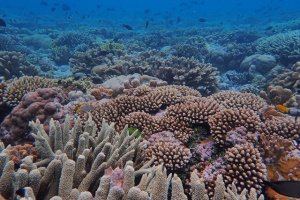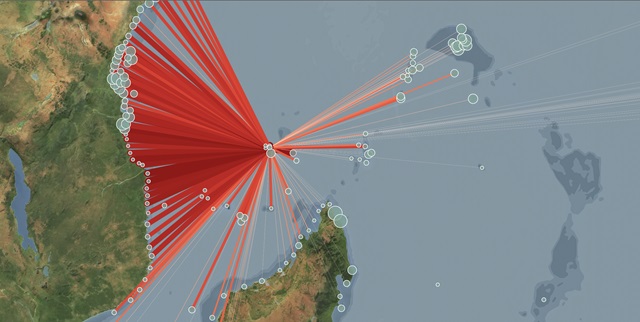Coral reef connectivity: University of Oxford and Seychelles' conservationists publish pioneering study
Research |Author: Betymie Bonnelame | April 21, 2024, Sunday @ 12:16| 24293 views
Coral reefs on Aldabra Atoll support an abundance of marine life. (Anne Koester)
Researchers from the University of Oxford in the UK and conservationists from Seychelles have published a pioneering study. For the first time, this study employs both genetics and oceanographic modelling to quantify the intricate network of coral connectivity in regional waters.
Amid the challenges posed by climate change and limited budgets, small island developing states (SIDS), housing tropical reef systems, are confronted with tough decisions regarding preserving their coral reefs.
According to the Seychelles Island Foundation (SIF), this research reveals a surprising connection among isolated coral reefs across Seychelles, showing that a complex system of ocean currents disperses substantial quantities of larvae among these far-flung islands, effectively functioning as a coral superhighway.
In this context, prioritising management efforts and strategically allocating resources becomes imperative, focusing on productive reefs that serve as significant exporters of larvae to other reef ecosystems.
Dr April Burt, a lead author of the study and SIF's consultant, said, "Coral larvae have been dispersing via ocean currents for millennia, but understanding how allows us to potentially exploit these natural processes to safeguard these larval supplies, which are so vital to the recovery of coral reefs after bleaching events."
By pinpointing major larval sources and delineating larval dispersal patterns, conservation strategies such as marine protected areas and reef restoration initiatives can be prioritised to bolster regional reef resilience.
The project was a collaborative effort between conservation organisations and entities across Seychelles, the government and the University of Oxford, with the financial support of the Blue Grants Fund through the Seychelles Conservation and Climate Adaptation Trust (SeyCCAT).
Marie-May Jeremie, SeyCCAT's chief executive and SIF Trustee, said, "In the face of a changing climate SeyCCAT is pleased to have funded such a project. Researches such as these are important in guiding decisions that will safeguard the integrity of coral reefs within the Seychelles and in the region."
 |
| Another outcome is a newly developed app that allows stakeholders to visualise larval dispersal simulations. (Dr Noam Vogt-Vincent) Photo License: All Rights Reserved |
Coral collections from so many far-flung reefs posed an enormous logistical challenge but conservation organisations and practitioners stepped up to facilitate this.
The Seychelles Parks and Gardens Authority (SPGA) provided boat and diver support for sites around Praslin and Mahe, Seychelles' two most populated islands.
The Marine Conservation Society Seychelles (MCSS) facilitated dives, while the Island Conservation Society (ICS) provided access and staff who collected coral samples on behalf of the wider team, as did Fregate Island.
SIF made huge in-kind contributions to cover diving extensively at Aldabra and Assumption, and even cruise ships helped out with lifts to the other outer islands; showing what can be achieved with collective effort.
Another outcome is a newly developed app that allows stakeholders to visualise larval dispersal simulations with a single click, offering unprecedented access to critical data for informed decision-making.
The chief executive of SIF, Dr Frauke Fleischer-Dogley said, "It is research like this that allows us to realise the importance of places like Aldabra. Although geographically distant from us, the wealth of Aldabra's reefs enriches the reef ecosystems in the whole of Seychelles, and beyond."
Back
